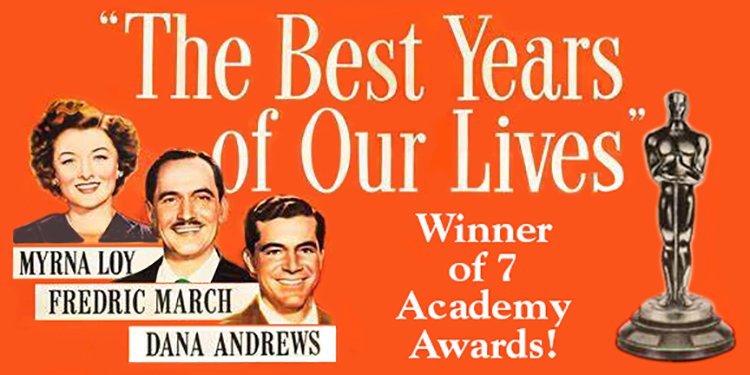Introduction:
“The Best Years of Our Lives,” directed by William Wyler, is a cinematic masterpiece that transcends its release year of 1946 to stand as a timeless exploration of the human experience post-World War II. This critically acclaimed film not only swept the Academy Awards but also resonated deeply with audiences for its poignant portrayal of veterans returning to civilian life. In this comprehensive review, we will delve into the multifaceted layers of this classic film, exploring its narrative depth, exceptional performances, and enduring relevance.
Section 1: The Historical Context
Released just a year after the end of World War II, “The Best Years of Our Lives” captures a pivotal moment in history when the world was reeling from the impact of the war. The film addresses the challenges faced by returning veterans as they navigate the complex landscape of post-war America. This historical backdrop adds depth and authenticity to the narrative, providing a lens through which audiences can reflect on the societal transformations of that era.
Section 2: Plot Summary
The narrative unfolds as three servicemen return to their hometown of Boone City after serving in different branches of the military during World War II. The central characters include Fred Derry (Dana Andrews), Al Stephenson (Fredric March), and Homer Parrish (Harold Russell). Each faces distinct challenges as they reintegrate into civilian life, grappling with the impact of war on their personal relationships and self-identity.
Fred Derry, a former bombardier, returns to a strained marriage and struggles to find meaningful employment. Al Stephenson, an older and wiser infantry sergeant, faces difficulties reconnecting with his family and adjusting to a corporate job. Homer Parrish, a sailor who lost both hands in combat, confronts the harsh realities of living with physical disabilities.
The film weaves together these individual stories, exploring the intersecting lives of the characters as they navigate the complexities of love, friendship, and societal expectations in a post-war America undergoing rapid transformation.
Section 3: Cinematic Craftsmanship
Director William Wyler, known for his meticulous attention to detail, brings a sense of authenticity to “The Best Years of Our Lives.” The cinematography by Gregg Toland is exemplary, capturing both the intimate moments of the characters’ lives and the broader societal changes with equal finesse. The film’s pacing, editing, and use of deep focus contribute to its narrative impact, creating an immersive experience for the audience.
Section 4: Exceptional Performances
The ensemble cast delivers performances that are not only compelling but also deeply resonant. Fredric March’s portrayal of Al Stephenson is nuanced and heartfelt, conveying the internal struggles of a man trying to reconcile the changes within himself and society. Dana Andrews brings a sense of vulnerability to Fred Derry, making the character’s emotional journey palpable. Harold Russell, a real-life veteran and double amputee, delivers a groundbreaking performance as Homer Parrish, capturing the resilience and spirit of those grappling with physical disabilities.
Myrna Loy, Teresa Wright, and Virginia Mayo also contribute memorable performances, adding layers to the narrative with their portrayals of women whose lives are intricately linked to the returning veterans.
Section 5: Themes and Social Commentary
“The Best Years of Our Lives” explores themes that transcend its immediate post-war context. It delves into the complexities of readjustment, PTSD, and the societal expectations placed on veterans returning to civilian life. The film addresses issues of identity, sacrifice, and the profound impact of war on the fabric of American society. Through its characters, the film becomes a poignant commentary on the universal human experience of navigating change and finding one’s place in the world.
Section 6: Harold Russell’s Impact
A notable aspect of the film is the casting of Harold Russell, a non-professional actor and actual war veteran who lost his hands during a training accident. Russell’s inclusion adds an unprecedented level of authenticity to the portrayal of a disabled veteran. His performance not only earned him an Academy Award but also contributed to the film’s groundbreaking representation of disability in cinema.
Section 7: Oscar Success and Cultural Legacy
“The Best Years of Our Lives” was a critical and commercial success upon its release, winning seven Academy Awards, including Best Picture, Best Director, and Best Actor in a Leading Role for Fredric March. Its enduring legacy is evident in its continued recognition as a cinematic masterpiece. The film remains relevant for its timeless exploration of human resilience, the impact of war, and the pursuit of the American Dream.
Section 8: Contemporary Relevance
While rooted in the aftermath of World War II, the themes explored in “The Best Years of Our Lives” continue to resonate in contemporary society. The challenges faced by veterans returning from conflict, the strain on familial relationships, and the quest for purpose and meaning are universal themes that transcend time and resonate with audiences today.
Section 9: Conclusion
“The Best Years of Our Lives” stands as a testament to the power of cinema to capture the complexities of the human experience. Its timeless narrative, exceptional performances, and profound social commentary ensure its place as a classic that continues to be celebrated and studied. As a reflection on the impact of war and the resilience of the human spirit, this film remains an enduring masterpiece that invites audiences to contemplate the enduring themes of love, sacrifice, and the pursuit of a better life.
